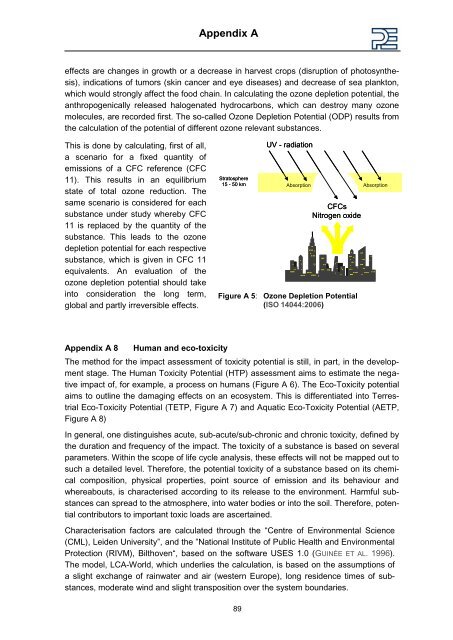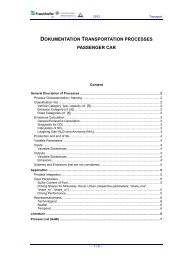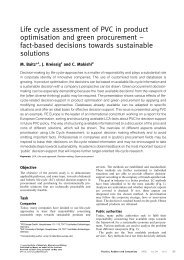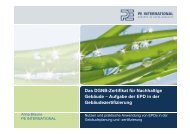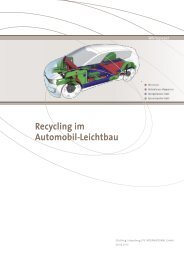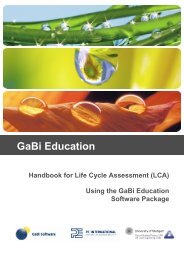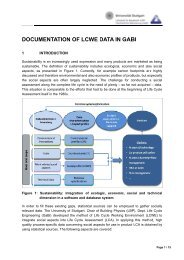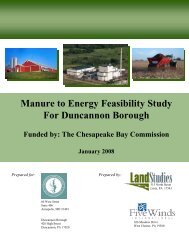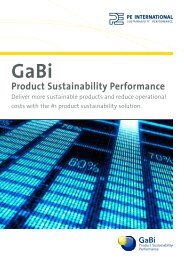Paper_Clip_Tutorial Part1.pdf - GaBi Software
Paper_Clip_Tutorial Part1.pdf - GaBi Software
Paper_Clip_Tutorial Part1.pdf - GaBi Software
Create successful ePaper yourself
Turn your PDF publications into a flip-book with our unique Google optimized e-Paper software.
Appendix A<br />
effects are changes in growth or a decrease in harvest crops (disruption of photosynthesis),<br />
indications of tumors (skin cancer and eye diseases) and decrease of sea plankton,<br />
which would strongly affect the food chain. In calculating the ozone depletion potential, the<br />
anthropogenically released halogenated hydrocarbons, which can destroy many ozone<br />
molecules, are recorded first. The so-called Ozone Depletion Potential (ODP) results from<br />
the calculation of the potential of different ozone relevant substances.<br />
This is done by calculating, first of all,<br />
a scenario for a fixed quantity of<br />
emissions of a CFC reference (CFC<br />
11). This results in an equilibrium<br />
state of total ozone reduction. The<br />
same scenario is considered for each<br />
substance under study whereby CFC<br />
11 is replaced by the quantity of the<br />
substance. This leads to the ozone<br />
depletion potential for each respective<br />
substance, which is given in CFC 11<br />
equivalents. An evaluation of the<br />
ozone depletion potential should take<br />
into consideration the long term,<br />
global and partly irreversible effects.<br />
Stratosphere<br />
15 - 50 km Absorption Absorption<br />
Figure A 5: Ozone Depletion Potential<br />
(ISO 14044:2006)<br />
Appendix A 8 Human and eco-toxicity<br />
The method for the impact assessment of toxicity potential is still, in part, in the development<br />
stage. The Human Toxicity Potential (HTP) assessment aims to estimate the negative<br />
impact of, for example, a process on humans (Figure A 6). The Eco-Toxicity potential<br />
aims to outline the damaging effects on an ecosystem. This is differentiated into Terrestrial<br />
Eco-Toxicity Potential (TETP, Figure A 7) and Aquatic Eco-Toxicity Potential (AETP,<br />
Figure A 8)<br />
In general, one distinguishes acute, sub-acute/sub-chronic and chronic toxicity, defined by<br />
the duration and frequency of the impact. The toxicity of a substance is based on several<br />
parameters. Within the scope of life cycle analysis, these effects will not be mapped out to<br />
such a detailed level. Therefore, the potential toxicity of a substance based on its chemical<br />
composition, physical properties, point source of emission and its behaviour and<br />
whereabouts, is characterised according to its release to the environment. Harmful substances<br />
can spread to the atmosphere, into water bodies or into the soil. Therefore, potential<br />
contributors to important toxic loads are ascertained.<br />
Characterisation factors are calculated through the “Centre of Environmental Science<br />
(CML), Leiden University”, and the ”National Institute of Public Health and Environmental<br />
Protection (RIVM), Bilthoven“, based on the software USES 1.0 (GUINÉE ET AL. 1996).<br />
The model, LCA-World, which underlies the calculation, is based on the assumptions of<br />
a slight exchange of rainwater and air (western Europe), long residence times of substances,<br />
moderate wind and slight transposition over the system boundaries.<br />
89<br />
UV - radiation<br />
CFCs<br />
Nitrogen oxide


